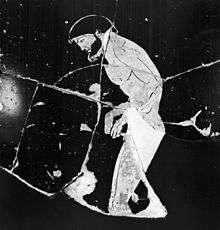Kynodesme

A kynodesme (Greek: κυνοδέσμη, English translation: "dog tie") was a cord or string[1] or sometimes a leather strip that was worn by some athletes in Ancient Greece and Etruria to prevent the exposure of the glans penis in public. It was tied tightly around the akroposthion, the part of the foreskin that extended beyond the glans. The kynodesme was worn temporarily while in public and could be taken off and put back on at will. It could either be attached to a waist band to expose the scrotum, or tied to the base of the penis so that the penis appeared to curl upwards. The public exposure of the penis head was regarded by the Greeks as dishonourable and shameful, something only seen in slaves and barbarians.[1] Modesty and decency demanded that men who showed themselves naked in a public setting, such as athletes or actors, must conceal their glans.[1][2]
It is first alluded to in literature in the 5th century BC, in the partially preserved satyr play Theoroi by Aeschylus. There is earlier evidence from the images of athletes on Ancient Greek pottery. The Kynodesme was also used by the Etruscans and Romans who called it a ligatura praeputii.[2] The Romans however preferred to use a ring, rather than a band, to conceal the glans known as a fibula.[2]
In Greek and Roman medical practice, the uncontrolled dispersing of semen was thought to weaken men, and was particularly thought to affect the quality of the masculine voice. In ancient Rome, this form of non-surgical infibulation might thus be used by singers as a regimen for preserving the voice.[3]
See also
References
- 1 2 3 Zanker, Paul (1995). The Mask of Socrates: The Image of the Intellectual in Antiquity. University of California Press. pp. 28–30. ISBN 9780520201057.
The way the mantle is draped actually emphasizes the poet's nudity and calls attention to a striking detail that has barely been noticed before: he has tied up the penis and foreskin with a string, a practice known as infibulation (or, in Greek, kynodesme) …But many examples of kynodesme in contemporary vase painting (fig. 18) suggest another explanation. Here it is almost exclusively symposiasts and komasts who have their phallus bound up in the same manner as Anacreon, and as a rule they are older men, or at least mature and bearded. Satyrs are also depicted, evidently for comic effect. To expose a long penis, and especially the head, was regarded as shameless and dishonourable, something we see only in depictions of slaves and barbarians. Since in some men the distended foreskin may no longer close properly, allowing the long penis to hang out in unsightly fashion, a string could be used to avoid such an unattractive spectacle, at least to judge from the evidence of vase painting. The vase also make it clear that this was a widely practised custom. We may then consider it a sign of the modesty and decency expected in particular of the older participants in the symposium. Once again, in the ideology of kalokagathia, aesthetic appearance becomes an expression of moral worth.
- 1 2 3 Ellis, Havelock (2013). Studies in the Psychology of Sex, Volume 1. Butterworth-Heinemann. p. 33. ISBN 9781483225012.
The Greeks, Etruscans, and Romans, appear to have been accustomed to cover the foreskin with the kynodesme (a band), or the fibula (a ring), for custom and modesty demanded that the glans should be concealed.
- ↑ Martial 6.82, Juvenal 6.73, 379; J.P. Sullivan, Martial, the Unexpected Classic (Cambridge University Press, 1991), p. 189; Peter Schäfer, Judeophobia: Attitudes toward the Jews in the Ancient World (Harvard University Press, 1997), p. 101; Peter J. Ucko, "Penis Sheaths: A Comparative Study," in Material Culture: Critical Concepts in the Social Sciences (Routledge, 2004), p. 260.
Sources
- Hodges FM. The Ideal Prepuce in Ancient Greece and Rome: Male Genital Aesthetics and Their Relation to Lipodermos, Circumcision, Foreskin Restoration, and the Kynodesme. Bulletin of the History of Medicine 2001;75:375–405.
- Osborne, Robin (2004). Greek History. London and New York: Routledge. ISBN 0-415-31717-7. page 10
- Keuls, Eva (1985). Reign of the Phallus. Berkeley and Los Angeles, California: University of California Press. ISBN 0-520-07929-9. page 68